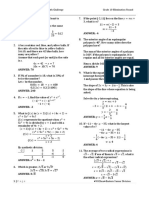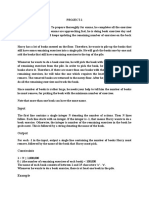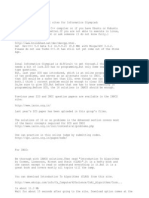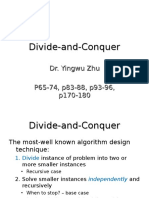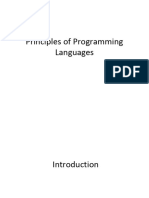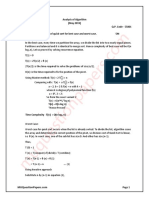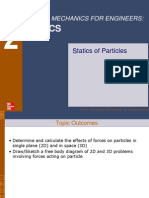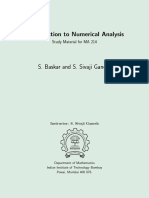Algorithm Complexity
Uploaded by
Malhar AnjariaAlgorithm Complexity
Uploaded by
Malhar AnjariaSection 2.
2
Complexity of Algorithms
Time Complexity: Determine the approximate number
of operations required to solve a problem of size n.
Space Complexity: Determine the approximate memory
required to solve a problem of size n.
________________
Time Complexity
- Use the Big-O notation
- Ignore house keeping
- Count the expensive operations only
Basic operations:
• searching algorithms - key comparisons
• sorting algorithms - list component comparisons
• numerical algorithms - floating point ops. (flops) -
multiplications/divisions and/or additions/subtractions
____________________
Worst Case: maximum number of operations
Average Case: mean number of operations assuming an
input probability distribution
Discrete Mathematics by Section 2.2
and Its Applications 4/E Kenneth Rosen TP 1
____________________
Examples:
• Multiply an n x n matrix A by a scalar c to produce
the matrix B:
procedure (n, c, A, B)
for i from 1 to n do
for j from 1 to n do
B(i, j) = cA(i, j)
end do
end do
Analysis (worst case):
Count the number of floating point multiplications.
n2 elements requires n2 multiplications.
time complexity is
O(n2)
or
quadratic complexity.
_________________
• Multiply an n x n upper triangular matrix A
A(i, j) = 0 if i > j
Discrete Mathematics by Section 2.2
and Its Applications 4/E Kenneth Rosen TP 2
by a scalar c to produce the (upper triangular) matrix B.
procedure (n, c, A, B)
/* A (and B) are upper triangular */
for i from 1 to n do
for j from i to n do
B(i, j) = cA(i, j)
end do
end do
Analysis (worst case):
Count the number of floating point multiplications.
The maximum number of non-zero elements in an n x n
upper triangular matrix
=1+2+3+4+...+n
or
• remove the diagonal elements (n) from the total (n2)
• divide by 2
• add back the diagonal elements to get
(n2 - n)/2 + n = n2/2 + n/2
which is
n2/2 + O(n).
Quadratic complexity but the leading coefficient is 1/2
Discrete Mathematics by Section 2.2
and Its Applications 4/E Kenneth Rosen TP 3
_________________
• Bubble sort: L is a list of elements to be sorted.
- We assume nothing about the initial order
- The list is in ascending order upon completion.
Analysis (worst case):
Count the number of list comparisons required.
Method: If the jth element of L is larger than the (j + 1)st,
swap them.
Note: this is not an efficient implementation of the
algorithm
procedure bubble (n, L)
/*
- L is a list of n elements
- swap is an intermediate swap location
*/
for i from n - 1 to 1 by -1 do
for j from 1 to i do
if L(j) > L(j + 1) do
swap = L(j + 1)
L(j + 1) = L (j)
L(j) = swap
end do
end do
end do
Discrete Mathematics by Section 2.2
and Its Applications 4/E Kenneth Rosen TP 4
• Bubble the largest element to the 'top' by starting at
the bottom - swap elements until the largest in the top
position.
• Bubble the second largest to the position below the
top.
• Continue until the list is sorted.
n-1 comparison on the first pass
n-2 comparisons on the second pass
1 comparison on the last pass
Total:
(n - 1)+ (n - 2) + . . . . + 1 = O(n2)
or
quadratic complexity
(what is the leading coefficient?)
_________________
Discrete Mathematics by Section 2.2
and Its Applications 4/E Kenneth Rosen TP 5
• An algorithm to determine if a function f from A to
B is an injection:
Input: a table with two columns:
- Left column contains the elements of A.
- Right column contains the images of the elements in
the left column.
Analysis (worst case):
Count comparisons of elements of B.
Recall that two elements of column 1 cannot have the
same images in column 2.
One solution:
• Sort the right column
Worst case complexity (using Bubble sort)
O(n2)
• Compare adjacent elements to see if they agree
Worst case complexity
O(n)
Total:
O(n2) + O(n) = O(n2)
Can it be done in linear time?
Discrete Mathematics by Section 2.2
and Its Applications 4/E Kenneth Rosen TP 6
You might also like
- TCP2101 Algorithm Design and Analysis Lab07 - Divide-and-ConquerNo ratings yetTCP2101 Algorithm Design and Analysis Lab07 - Divide-and-Conquer5 pages
- 2017 MMC Grade 10 Eliminations Questions With Answers87% (86)2017 MMC Grade 10 Eliminations Questions With Answers8 pages
- Dynamic Programming: Louis Siu 13.9.2007No ratings yetDynamic Programming: Louis Siu 13.9.200743 pages
- CS449 - Syllabus-Algorithms & ComplexityNo ratings yetCS449 - Syllabus-Algorithms & Complexity5 pages
- Brute Force: Design and Analysis of Algorithms - Chapter 3 1No ratings yetBrute Force: Design and Analysis of Algorithms - Chapter 3 118 pages
- Data Structures and Algorithms AssignmentNo ratings yetData Structures and Algorithms Assignment8 pages
- Algorithm Analysis Design Lecture1 PowerPoint PresentationNo ratings yetAlgorithm Analysis Design Lecture1 PowerPoint Presentation9 pages
- Chapter 10: Algorithms 10.1. Deterministic and Non-Deterministic AlgorithmNo ratings yetChapter 10: Algorithms 10.1. Deterministic and Non-Deterministic Algorithm5 pages
- Cs 6402 Design and Analysis of AlgorithmsNo ratings yetCs 6402 Design and Analysis of Algorithms112 pages
- Data Structures and Algorithms ProblemsNo ratings yetData Structures and Algorithms Problems20 pages
- Principals of Programming Languages 1.1No ratings yetPrincipals of Programming Languages 1.141 pages
- Levitin: Introduction To The Design and Analysis of AlgorithmsNo ratings yetLevitin: Introduction To The Design and Analysis of Algorithms35 pages
- Computer Algoritham For Chennai Univarsity Unit5No ratings yetComputer Algoritham For Chennai Univarsity Unit511 pages
- Simple Sorting and Searching Algorithms 2.1searching: PseudocodeNo ratings yetSimple Sorting and Searching Algorithms 2.1searching: Pseudocode7 pages
- Design and Analysis of Algorithms (CS501PC) PDFNo ratings yetDesign and Analysis of Algorithms (CS501PC) PDF19 pages
- Iare Oops Through Java Lab Manual Updated 0No ratings yetIare Oops Through Java Lab Manual Updated 0121 pages
- Visvesvaraya Technological University: Web Technology and Its Applications Practical Assessment (18Cs63)No ratings yetVisvesvaraya Technological University: Web Technology and Its Applications Practical Assessment (18Cs63)20 pages
- Equity of Cybersecurity in the Education System: High Schools, Undergraduate, Graduate and Post-Graduate Studies.From EverandEquity of Cybersecurity in the Education System: High Schools, Undergraduate, Graduate and Post-Graduate Studies.No ratings yet
- Beginning C# 3.0: An Introduction to Object Oriented ProgrammingFrom EverandBeginning C# 3.0: An Introduction to Object Oriented ProgrammingNo ratings yet
- Notes On Divide-and-Conquer and Dynamic Programming.: 1 N 1 n/2 n/2 +1 NNo ratings yetNotes On Divide-and-Conquer and Dynamic Programming.: 1 N 1 n/2 n/2 +1 N11 pages
- Be Computer Engineering Semester 4 2019 May Analysis of Algorithms CbcgsNo ratings yetBe Computer Engineering Semester 4 2019 May Analysis of Algorithms Cbcgs19 pages
- EE 204 Chapter 3 Vector Calculus Part 2No ratings yetEE 204 Chapter 3 Vector Calculus Part 217 pages
- Block Diagram Representation of Control Systems100% (2)Block Diagram Representation of Control Systems49 pages
- Second Diagnostic Test in Mathematics 2 S.Y. 2022-2023No ratings yetSecond Diagnostic Test in Mathematics 2 S.Y. 2022-20233 pages
- High School Mathematics Competition 2010: First Round, Basic LevelNo ratings yetHigh School Mathematics Competition 2010: First Round, Basic Level4 pages
- Graphs, Linear Equations, and FunctionsNo ratings yetGraphs, Linear Equations, and Functions42 pages
- Mathematics Grade 9 June Investigation FinalNo ratings yetMathematics Grade 9 June Investigation Final7 pages
- AS pure mathematics C1 C2 3rd ed Edition Val Hanrahan instant download100% (1)AS pure mathematics C1 C2 3rd ed Edition Val Hanrahan instant download77 pages
- 1 Integration by Substitution (Change of Variables) : 1.1 Example ProblemsNo ratings yet1 Integration by Substitution (Change of Variables) : 1.1 Example Problems11 pages
- Bhavesh Krishan Garg Cse2b-G1 (Octave Lab-03)No ratings yetBhavesh Krishan Garg Cse2b-G1 (Octave Lab-03)13 pages
- Searching For Homogeneity Across Multi-Variable Polynomials: 1 TheoryNo ratings yetSearching For Homogeneity Across Multi-Variable Polynomials: 1 Theory7 pages
- State Level Preparatory Maths Key- By Ganesha a SNo ratings yetState Level Preparatory Maths Key- By Ganesha a S23 pages
- (Master Thesis at University of Memphis) Thomas Rexford Fleming - Polynomial Methods - Recent Advancements in Combinatorics (2022)No ratings yet(Master Thesis at University of Memphis) Thomas Rexford Fleming - Polynomial Methods - Recent Advancements in Combinatorics (2022)80 pages
- مراجعة فبراير - ماث - 1 ع - ذاكرولي PDFNo ratings yetمراجعة فبراير - ماث - 1 ع - ذاكرولي PDF115 pages


